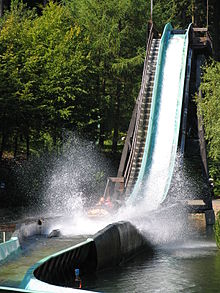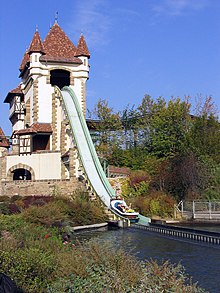Flume
A wild water ride is a water ride at folk festivals and amusement parks . The principle is based on a wooden giant , which was used to transport cut tree trunks from the mountains. The boats, often shaped like tree trunks, swim in canals with flowing water and go down slopes.
history
Already at the beginning of the twentieth century there were boat trips in amusement parks with boats propelled by water currents. Most of these were designed as themed dark rides .
The first stationary flume in today's sense, built by Arrow , was opened in 1963 at the Six Flags over Texas amusement park . It was developed primarily by Karl Bacon and Ed Morgan . The first European train was built in 1967 in the English amusement park Blackpool Pleasure Beach . In Germany, the Arrow trains were produced under license by the Mack company, until the company developed its own variant after a short time. In 1974 Phantasialand was the first German park to present a wild water run. Since the capacity of the self-built track was no longer sufficient, it was split up in 1992 into the two tracks Stonewash and Wildwash Creek . At the end of 2011, the two whitewater courses were demolished to make way for Chiapas , which according to the park is currently the most modern waterway.
Today there is a wild water course in almost every major theme park. The various manufacturers are as numerous as the systems.
In addition to the widespread tree trunk design, there are also facilities with bathtubs ( Tripsdrill Adventure Park ), menhirs ( Parc Astérix ), barrels ( Holiday Park Haßloch ), bobsleighs ( Panorama Park Sauerland ) and many other boats.
Transportable railways

In addition to the stationary systems in parks, transportable ropeways for public festivals were also built from the early 1980s onwards.
Mack made the start in 1982 with a train for the Löwenthal showman family. It was problematic at first to seal the channels. However, as experience grew, this problem was resolved. Eight mobile systems are currently traveling in Germany. The largest transportable ropeway in the world was the Wildwasser 3 built in 1992 by the Bremen showman Joachim Löwenthal. It has a footprint of 60 × 40 meters and a height of 26 meters. The total weight is 1,000 t. So-called side loaders , which are also used to transport the 60 m Ferris wheels , are used for transport to the train station . A total of 60–65 railway wagons are required to move the whitewater course. The purchase price in 1992 was DM 12 million.
technology



The boats swim in narrow channels, often made of plastic, but also of metal or concrete. Due to a slight gradient, they are carried by the water flow generated by the pumps. In order to make larger descents possible, the boats are pulled up on a ramp by means of an electrically powered lift. Usually special plastic or rubber conveyor belts are used. Chain lifts are also used on some railways.
On the following descent, which is up to 20 meters high, the boats roll down on wheels attached to the bottom of the boat. Only when they reach the bottom do they drive again into a water channel, where they are slowed down by the water resistance. Due to the displacement of the water, the water splashes up in places, and passengers can also get wet. The bow of the boats is shaped in such a way that as much water as possible is kept away from the occupants and that the braking effect is optimal and not too abrupt. For guidance in the channel, additional wheels are mounted at the bottom in a horizontal direction.
Some white water courses have a rotating platform, which means that the boats can also go down slopes in reverse. The turntables are also used to save space in order to avoid curves in tight spaces. Individual specimens even have driveways that they master on their own, i.e. only through their kinetic energy .
The boats are usually designed for a maximum of four or six people sitting in a row. With these types of boats there are usually no lap bars, the passengers have to hold on to side bars or handles. In other less common types of boats, two passengers sit next to each other, the boats then usually have four rows for a total of eight people.
Different types of stations are used for getting in and out. In the oldest version, which is now hardly in use, the boats in the water channel are lifted slightly from the front and below using a hydraulic system, preventing them from moving on. The most common today are stations where the boats are slowly moved forward on a conveyor belt and visitors get in while they are in motion. The third variant are round loading stations, similar to those used for rapids , in which the boats swim synchronously with a rotating disk. The passengers get on via this window.
Children's wild water slide
Since there are requirements regarding the age and height of passengers for safety reasons, some manufacturers also have systems specifically for children in their range. Smaller boats for a maximum of three children or one child with an adult are used here. The runs are also significantly lower. The first system of this kind in Germany was the Mühlbachfahrt in the Tripsdrill adventure park from ABC Engineering , equipped with boats designed as flour sacks .
Manufacturer (selection)
- ABC engineering
- Arrow Dynamics
- Bear rides
- Fabbri Group
- Hafema
- Hopkins
- Intamin
- Interlink
- L&T Systems
- Mack Rides
- Mannesmann Demag
- Reverchon
- SBF Visa Group
- Schwarzkopf GmbH
- SDC
- Soquet
- Van Egdom
- Zamperla Rides
literature
- Ralph Latotzki et al. a .: AquaPlan, special edition of the club magazine park + ride of the Freundeskreis Kirmes und Freizeitparks eV


